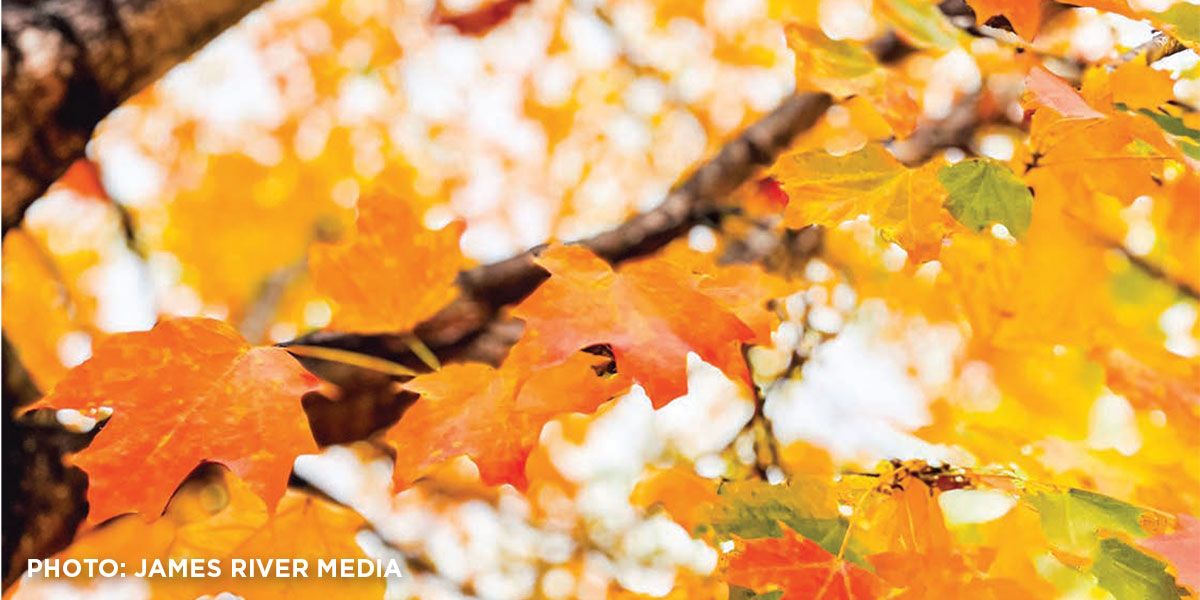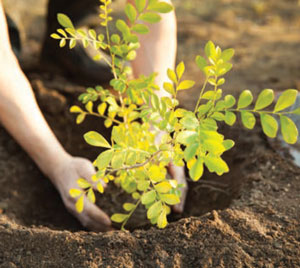TREE TALK

Local experts give fall tips for planting & pruning
When we think of trees this time of year, we’re more than likely looking forward to the beautiful foliage they yield. However, fall also brings some great benefits when it comes to planting trees. While spring is also a good time to plant for numerous reasons — extra sunlight with the longer days, warm soil temperatures and spring showers — the advantages of fall plant installation should not be overlooked.
A season for planting
Berkeley Jones, manager of Townside Gardens’ landscaping division in Roanoke, says fall is a great time to plant.
“Water requirements typically go down in the fall with lower temperatures; therefore, less watering will be required of the homeowner,” Jones says. “The roots of your plants will also grow well into December. This extra period of root growth allows the plants to establish themselves well before the summer months.”
There are a number of factors to consider when choosing and installing a new tree. Spending the time upfront to research and talk to professionals will go a long way in ensuring proper structure from the start.
“First, I would develop a budget as this can narrow down your options and make the search a little easier,” Jones says. “Consider the mature height and width of the tree as well as the growth rate, and space your plants appropriately from buildings or roads. Color should be considered as well, and I would also consider whether you prefer a fruiting tree or non-fruiting.”
 Choosing a tree
Choosing a tree
Adam Braaten, an ISA Board Certified Master Arborist, has worked for Bartlett Tree Experts in Roanoke for the last 20 years. He believes the first step in planting is to choose a strong nursery stock with favorable structure.
“If you are planting a shade tree, it should start life with one central stem to reduce future structural problems. Small, flowering trees may be multi-stemmed, but ideally should not have a lot of crossing and closely spaced branches,” Braaten says. “It is also very important to plant all trees at the proper depth. The root collar should be positioned at grade level. Many trees experience problems later in their life because they were either planted too deep or too high.”
If you plan to install a tree yourself, call VA811 before you dig. They will send a crew out — free of charge — to mark the utilities in your yard and ensure that a small project doesn’t turn into a very expensive one.
Tree maintenance
As far as upkeep, most well-placed trees will not have to be pruned other than removing any dead wood or crossing branches. Some trees may need to be pruned yearly or every few years depending on how close they are to homes. Other maintenance tasks to keep in mind are fertilizing, mulching and, of course, watering.
“Fertilize as needed in early spring and late fall,” Jones says. “We also recommend mulching, which helps the soil to hold moisture, preventing drought stress on shrubs. It also helps to suppress weeds and will break down over time into soil, providing nutrients to your plants for years. It is also critical that you continue to water new plantings throughout the fall and winter. Plants are still using and losing moisture even when dormant.”
Braaten adds that deer fencing is also very important this time of year.
“Protecting juvenile trees from deer damage is the most essential way to prepare them for the fall and winter seasons,” he says. “Buck antler rub can be very harmful to newly planted and juvenile trees. The installation of fencing and/or stakes around the tree’s main stem is the best way to protect the stem and lower branches from damage.”
It is typically ideal to consult a professional and do your research before taking on any landscape project yourself. Improper pruning can promote rot and provide homes for pests in your trees and shrubs. Over-mulching can kill plants and cause fungal growth in your beds. And trimming large trees yourself can also carry a high risk of property damage or personal injury.
“Professional tree pruners should be utilized whenever branches are out of reach or when homeowners do not feel confident in their skill or knowledge,” Braaten says. “Small, ornamental trees can be negatively affected by improper pruning, and poor pruning practices can lead to sunscald and improper branch spacing.”
As you enjoy cooler fall weather, plan ahead for any planting or maintenance that needs to be done before winter. You’ll enjoy the “foliage of your labor” for years to come! ✦
allelopathic, deer damage/antler rub, landscape project, mature height, Ornamental Trees, Patios, planting, professional tree services, root ball, sheds, sidewalks, tree maintenance, tree pruners, Water requirements







